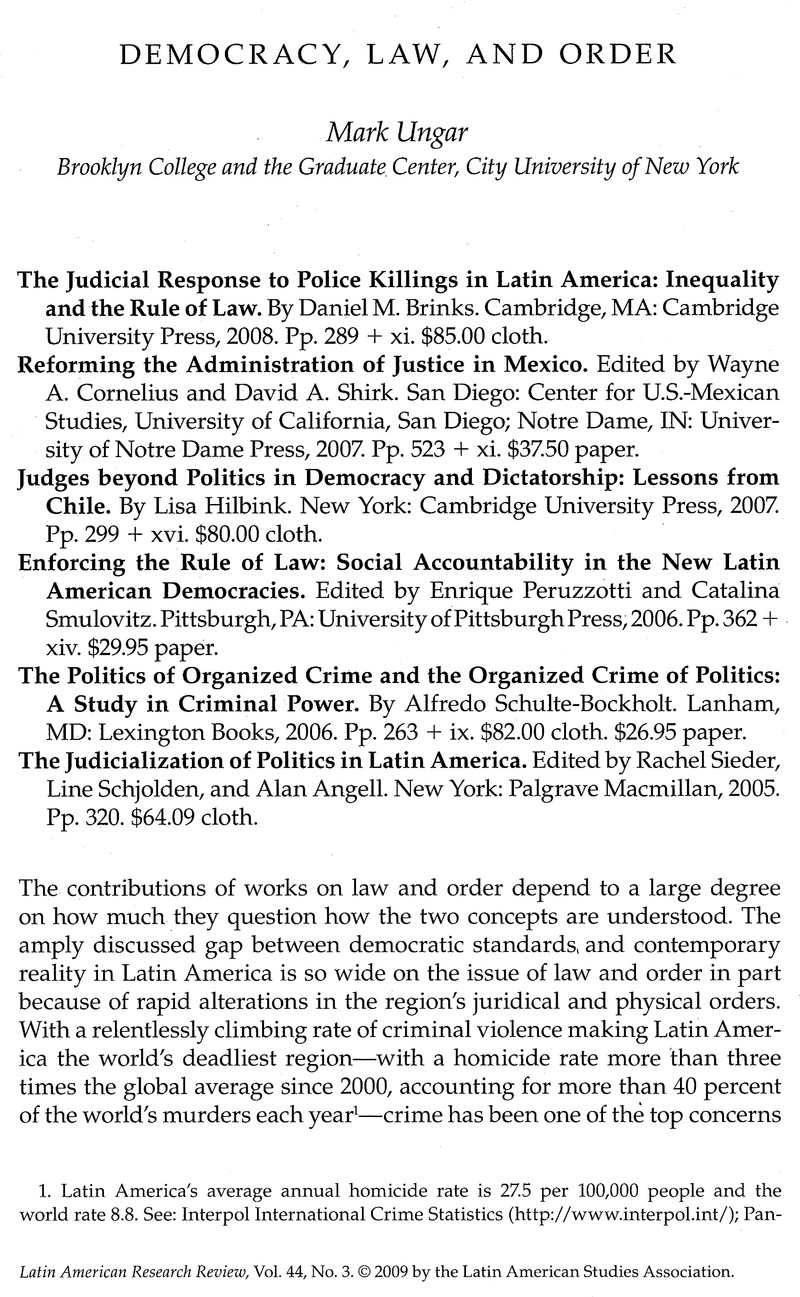Published online by Cambridge University Press: 05 September 2022

1. Latin America's average annual homicide rate is 27.5 per 100,000 people and the world rate 8.8. See: Interpol International Crime Statistics (http://www.interpol.int/); Pan-American Health Organization, Health in the Americas, Volume I (Washington, D.C.: Pan-American Health Organization, 2002); United Nations Interregional Crime and Justice Research Institute, Criminal Victimization in the Developing World (Rome: United Nations, 2006). Half of the ten most criminally violent countries in the world are Latin American: El Salvador, Venezuela, Colombia, Brazil, and Honduras.
2. In the Latinobarómetro survey, crime is statistically tied with unemployment as the problem considered by respondents to be most important, more than doubling between 2001 and 2007.
3. Among canonical works on community policing, see Herman Goldstein, Problem-Oriented Policing (New York: McGraw-Hill, 1990).
4. Soraya El Achkar, “Police Reform in Venezuela,” in Best Community Policing Practices in Latin America, ed. Mark Ungar and Desmond Arias (forthcoming).
5. “Deadly Message,” The Economist, July 19, 2008, p. 47
6. Guillermo O'Donnell, “On the State, Democratization, and Some Conceptual Problems,” World Development 21 (1993): 1355–1369.
7. World Prison Population List (London: International Centre for Prison Studies, 2005), http://www.kcl.ac.uk/depsta/law/research/icps/worldbrief/.
8. As many scholars discuss, the law comprises rules as well as rules about rules (e.g., penal process codes). See Philippe Nonet and Philip Selznick, Law and Society in Transition (New Brunswick, NJ: Transaction Publishers, 1978); and Austin Sarat and Thomas Kearns, eds., Law's Violence (Ann Arbor: University of Michigan Press, 1995).
9. The court ruled that the law violated prohibition of punishment for acts not defined as crimes and that its implementation by executive officials violated the right to a natural judge.
10. Personal interview with Luis Enrique Oberto, legislative commission president, June 29, 1998.
11. Carlos Arguedas, “80 por ciento de denuncias por el delito de violación no llegan a juicio,” La Nación (Costa Rica), July 3, 2005, 16a.
12. Piet Van Reenen, “Policing Extensions in Latin America,” in Armed Actors: Organised Violence and State Failure in Latin America, ed. Kees Koonings and Dirk Kruijt (London: Zed Books, 2004), 33–51.
13. Timothy Mitchell, “The Limits of the State: Beyond Statist Approaches and Their Critics,” American Political Science Review 85, no.1 (1991): 90.
14. See Juan J. Linz and Alfred Stepan, Problems of Democratic Transition and Consolidation (Baltimore: Johns Hopkins University Press, 1996); and Frances Hagopian and Scott P. Mainwaring, eds., The Third Wave of Democratization in Latin America (New York: Cambridge University Press, 2005).
15. See Peter Evans and Elinor Ostrom, eds., State-Society Synergy (Berkeley: University of California Press, 1997); and Merilee S. Grindle, Despite the Odds: The Contentious Politics of Education Reform (Princeton, NJ: Princeton University Press, 2004).
16. See, among other works, Guillermo O'Donnell, Jorge Vargas Cullell, and Osvaldo M. Iazzetta, The Quality of Democracy: Theory and Applications (Notre Dame, IN: University of Notre Dame Press, 2004).
17. Luis Gerardo Gabaldón, Presencia policial en zonas residenciales urbanas (Mérida, Venezuela: Universidad de los Andes, 1988).
18. Andreas Schedler, “Conceptualizing Accountability,” in The Self-Restraining State, ed. Andreas Schedler, Larry Diamond, and Marc Plattner (Boulder, CO: Lynne Rienner, 1999), 25.
19. Scott Mainwaring, “Introduction,” in Democratic Accountability in Latin America, ed. Scott Mainwaring and Christopher Welna (Oxford: Oxford University Press, 2003), 4.
20. Susana Rotker, ed., Citizens of Fear: Urban Violence in Latin America (New Brunswick, NJ: Rutgers University Press, 2002), 17.
21. John Keane, “Fear and Democracy,” in Violence and Democracy, ed. Kent Worcester, Sally Bermanzohn, and Mark Ungar (New York: Routledge, 2001), 235.
22. Scott Johnson, “Vigilante Justice,” Newsweek, December 20, 2004, 22–23.